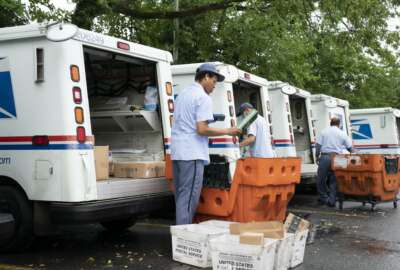Federal appeals court casts doubts on lawsuit challenging higher USPS rates
The U.S. Court of Appeals for the D.C. Circuit suggested the Postal Regulatory Commission could allow USPS to set even higher prices for the mail products it has a...
Federal appeals court judges are casting doubts on a lawsuit that challenges the Postal Service’s ability to set mail rates higher than the pace of inflation.
A three-judge panel with the U.S. Court of Appeals for the D.C. Circuit set a high bar for plaintiffs during oral arguments on Monday, and suggested the Postal Regulatory Commission (PRC) could allow USPS to set even higher prices for the mail products it has a monopoly over in the coming years.
The legal battle stems from the commission’s mandate under the 2006 Postal Accountability and Enhancement Act to run a 10-year review of the formula it uses to set USPS mail rates. As part of that review, PRC had to ensure its rate-setting system met nine statutory objectives meant to ensure the long-term sustainability of USPS.
During that review, the PRC found that the USPS rate-setting system “did not meet the objectives relating to the financial health” of the Postal Service.
The PRC introduced a new rate-setting system in December that would keep a price cap on market-dominant products like first-class mail, but allow USPS to set prices above the rate of inflation based on changes in mail density and its workforce retirement costs.
The PRC’s new rate-setting system, however, remains a compromise. The lawsuit’s plaintiff, the National Postal Policy Council, argued the commission went too far in giving USPS the ability to set rates above inflation, while USPS attorneys argued the commission didn’t go far enough to give the agency flexibility to adjust prices and regain long-term financial stability.
Under this new framework, USPS in August raised the price of most mail products by 6.8%, including the price of a first-class stamp, which went up from 55 cents to 58 cents. Magazines, newspapers and catalogs saw an 8.8% price increase.
The court denied a request from the National Postal Policy Council last month to block USPS from raising rates on first-class mail and periodicals until its ongoing lawsuit is settled.
Plaintiff’s attorney Ayesha Khan argued that the commission’s new rate-setting system didn’t adequately account for the statutory objective that USPS provide “predictable and stable rates.”
But Judge David Tatel and Judith Rogers pushed back on that argument, saying the plaintiffs would have to prove that the commission didn’t just misapply one factor, but that its balancing of all nine factors together was “arbitrary and capricious.”
“You’ve made exactly the argument I would expect you to make — that the commission should have balanced some of these factors differently, and in your favor. The Postal Service looks at the same factors and argues that the commission should balance them differently. But what we have here is everybody agrees that the commission considered the factors, took them into account and made a judgment — and it’s very hard for me to see how we can second-guess that,” Tatel said.
Khan said the PRC didn’t give equal consideration to some factors, such as maximizing USPS incentives to cut costs, increase efficiency and meet service targets.
By implementing a rate-setting system that allows USPS to charge higher rates based in part on a decline in mail density, Khan said USPS would essentially receive more money for a greater decline in service.
“They adopted authorities that did nothing about any of that. Nothing — ignored it completely. None of the money they get needs to go to improvement. They receive the full amount of costs attributable to volume declines, even the portion caused by poor service, or even the portion that would have been ameliorated by inefficiencies. And so what they’ve done is they rewarded the decline,” Khan said.
The commission, she added, found USPS hasn’t met many of its own cost-savings projections and that the agency’s productivity has declined in recent years.
USPS attorney David Belt told the court that the PRC, in its 10-year review, recognized that the previous rate-setting system wouldn’t allow USPS to remain financially stable in the long term. However, Belt said the commission’s changes in the new rate-setting system are “not themselves sufficient” for USPS to reach its financial stability objectives.
USPS is instead petitioning the PRC for a “reset” of market-dominant product prices, in order for the agency to adequately cover its costs.
“We’re not asking for unregulated, unfettered pricing authority. Certainly, unregulated, unfettered pricing authority would achieve the financial stability objective, but it would undermine other objectives,” Belt said.
Belt said USPS has cut costs and increased efficiency over the past 10 years, but he said USPS revenue hasn’t covered its operating costs for the past 14 years, and “further cost-cutting would be difficult in light of our legal obligations and restraints.”
“Our position is that any rate-making system that doesn’t allow the Postal Service a reasonable opportunity to cover its costs is unreasonable,” Belt said.
Tatel noted that PAEA mandated a 10-year review from the PRC, but beyond that, the commission was free to revisit its rate-setting system for USPS at any point, and could entertain more petitions from USPS to raise its rates.
“It just seems to me that the statute so clearly gives the commission more power after the 10-year period than it did in the first,” Tatel said.
Justice Department attorney Dana Kaersvang argued that the PRC was “plainly within its statutory authority” in creating a new rate-setting system.
“The commission’s bottom line here makes a lot of sense, because nobody really disputes that the inflation-based price cap was standing in the way of achieving the objectives. Rates were not reasonable, because they were below cost,” Kaersvang said.
By keeping the price cap in place, Kaersvang said the PRC targeted losses outside the USPS’s control, while encouraging the agency to still cut costs and prevent rates from going up too rapidly.
“The commission recognized that there is a lot of uncertainty here, and it will review the system again in five years, or earlier, if necessary,” Kaersvang said.
Copyright © 2025 Federal News Network. All rights reserved. This website is not intended for users located within the European Economic Area.
Jory Heckman is a reporter at Federal News Network covering U.S. Postal Service, IRS, big data and technology issues.
Follow @jheckmanWFED






